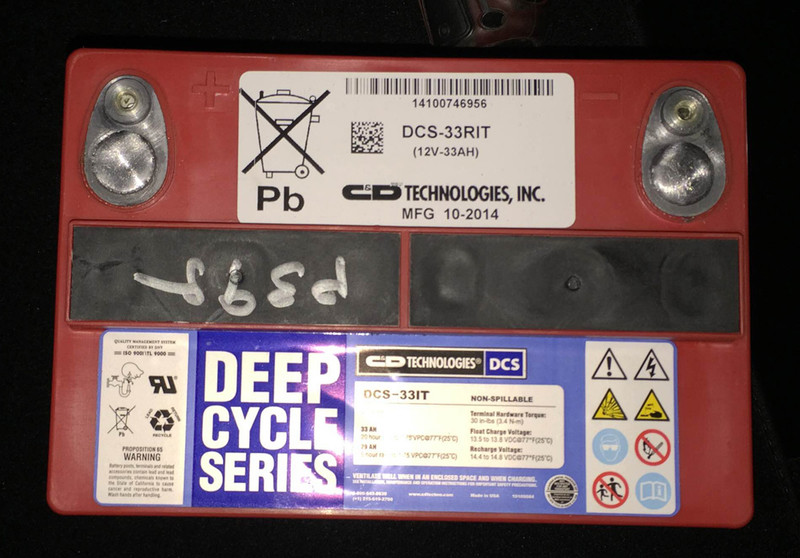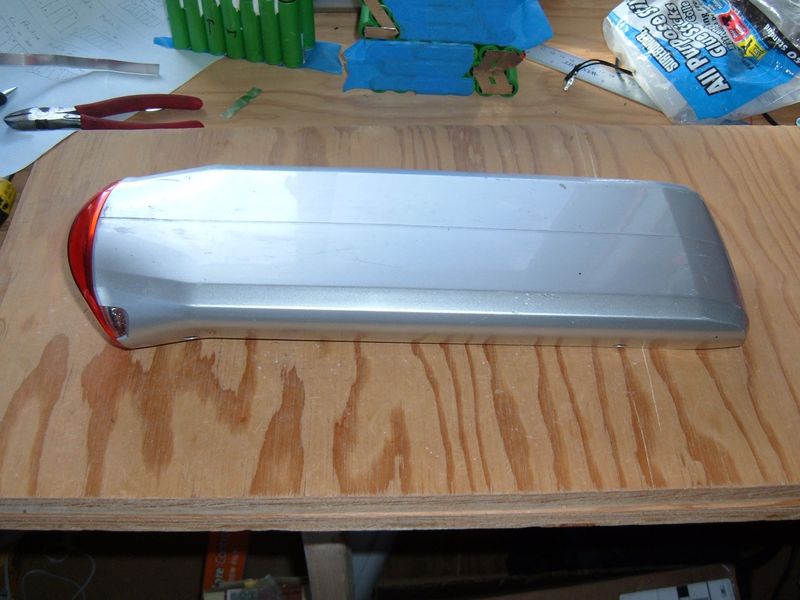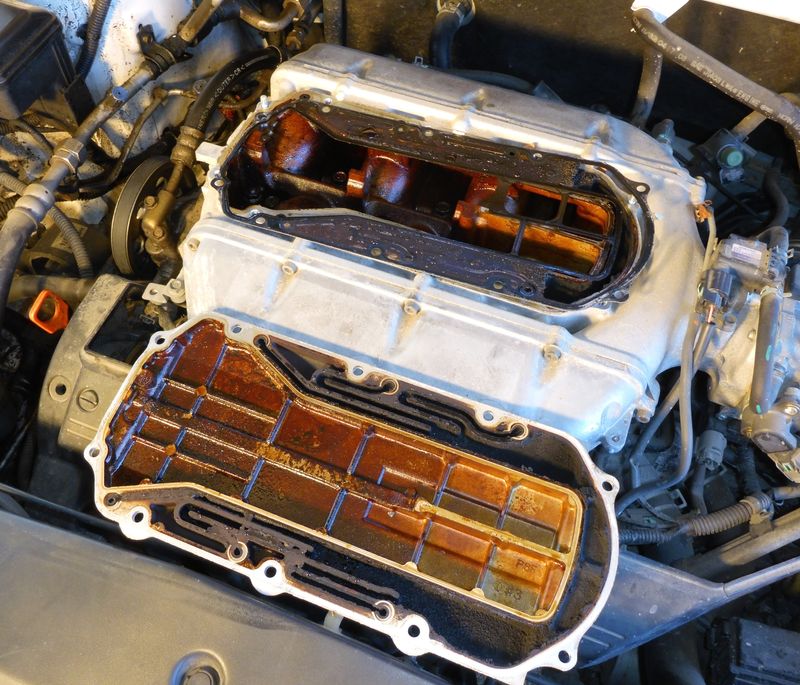It would be great to be able to start this post talking about how the Model S, much to the amazement of many owners, has a 12V lead acid battery. Sadly, I can’t do that - because this battery is a failure-prone sore point among many owners, and far too many owners with a >2 year old car are entirely aware of it, as the battery has already failed and been replaced at least once.
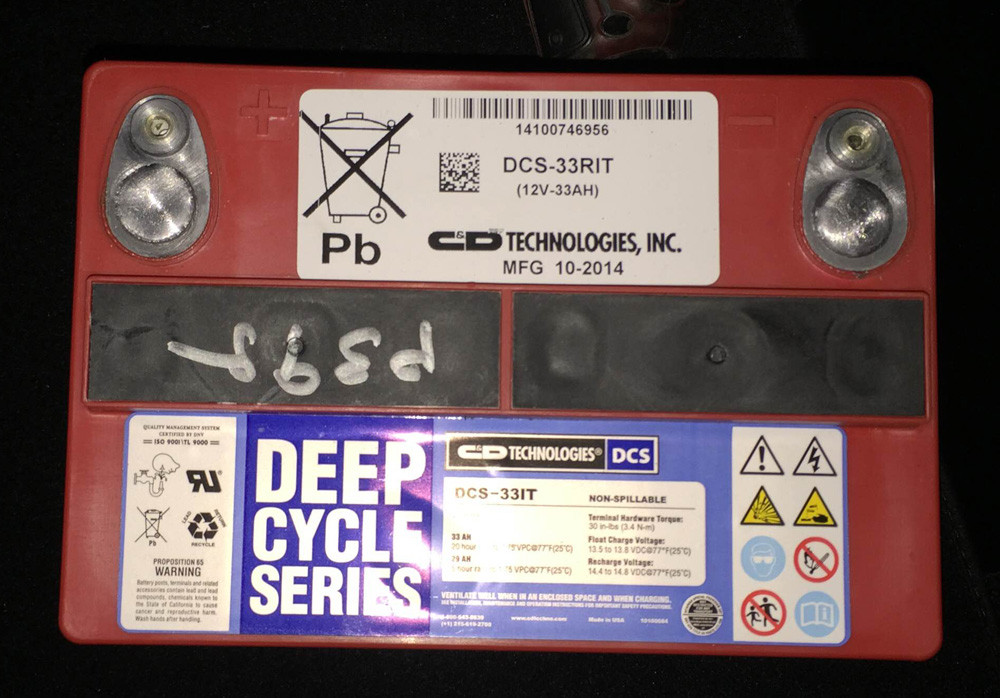
This little gizmo is the cause of an awful lot of unhappiness with the Model S.
I don’t own a Model S, but I do know a little bit about batteries - and while most of my work is with lithium battery packs, I also know a bit about lead acid batteries, as my office uses a good sized bank of them (about 225Ah at 48V, depending on rate) for solar energy storage. No, I couldn’t get my hands on a PowerWall, and no, one wouldn’t even be useful to me voltage-wise. Though if you have one laying around you’d be willing to part with, let me know…
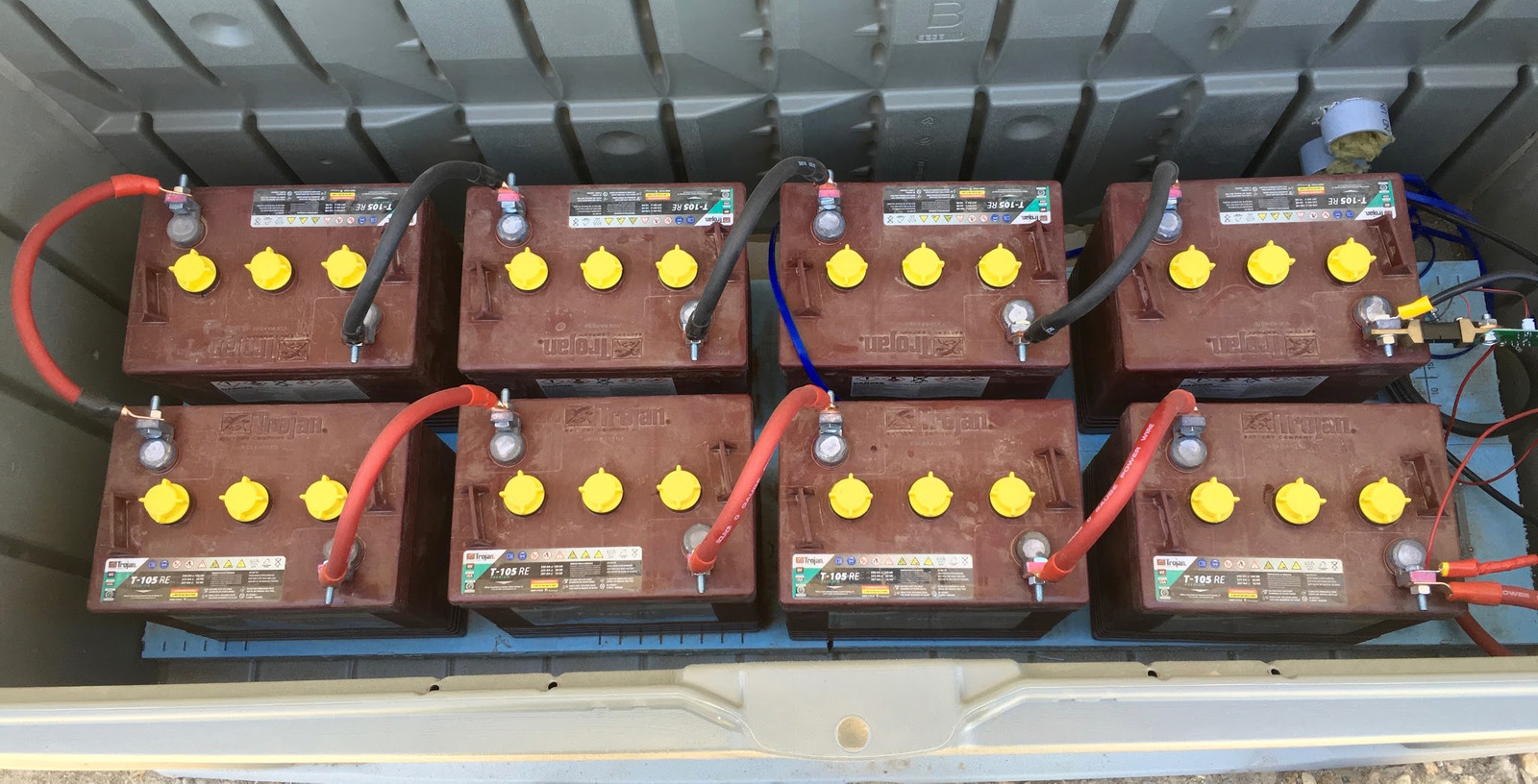
Anyway. I was wandering around the internet and came across something interesting.
I’ve got, on my flash chips, this tiny little file that, on analysis, turns out to be a few days worth of data log from a Model S 12V battery system in late 2016. Voltage, amperage into or out of the battery, and some surrounding data about charge state and the like. Rumor has it that the power settings are “Energy Saving : Off” & “Always Connected : On.”
So, in I dive! Chart a course to graphs!
Why Lead Acid?
First, it’s important to explain why the Model S has a 12V lead acid battery in the first place - and why the battery is lead acid as opposed to one of the assorted lithium chemistries (which is a common question every now and again as people find out that, surprisingly, their lithium powered car has a lead acid battery).
Lead acid is a very, very old battery chemistry - it was invented in 1859, so it’s over 150 years old at this point. There have been many refinements over the years, but at the core, you’ve got lead plates, sulfuric acid, and chemistry. The energy density is poor, but the power density can be quite good (this is why it’s used in most cars - it’s great at turning starter motors for a few seconds).
Lead acid also has a very important characteristic: If properly charged, it doesn’t freeze (above -90F or so) - and it can charge and discharge safely over an incredibly wide temperature range without being damaged. That’s not true of lithium chemistries. If you try to charge a lithium batter when cold, you end up with lithium plating, which permanently reduces capacity. Lead acid will put out less power and energy when cold (this is why “cold cranking amps” matter), but it’s not damaged by use in the cold.
Discharging doesn’t damage lithium in the cold (it lacks power, but isn’t otherwise affected) - but charging when cold is really bad. The Model S will use the charger power to heat the battery pack before charging, if needed. Fine for a traction battery, not so good for a regularly cycled utility battery.
Cars have to operate reliably over a huge range of temperatures, and lead acid is really good for providing basic power to a car. Also, every single car part out there in parts bins is designed to work on a 12V lead acid battery operating range.
The Model S uses the 12V system to run pretty much everything. The computers run off the 12V system, the interior electronics (locks, windows, seats, etc) run off 12V, and the main contactor for the big battery underneath requires a functioning 12V system. If the 12V battery is dead, so is the car. There are jump start terminals (which, by the way, you shouldn’t use to jump another car), but the Model S is entirely reliant on this 12V lead acid battery to function.
If you replaced this 12V battery with a lithium battery, you’d have to add heaters and the like to it - you simply cannot safely charge a lithium battery below about the freezing point of water. Of course, if you never let your car below about 40F, a LiFePO4 drop in replacement would probably work fine, assuming the computers didn’t notice and complain.
The Model S Lead Acid Battery: DCS-33RIT
The Model S 12V battery lives somewhere ranging from “convenient to replace” to “really damned annoying to replace,” depending on the particular options. It’s orange, here, in one photo that did the rounds a while ago.
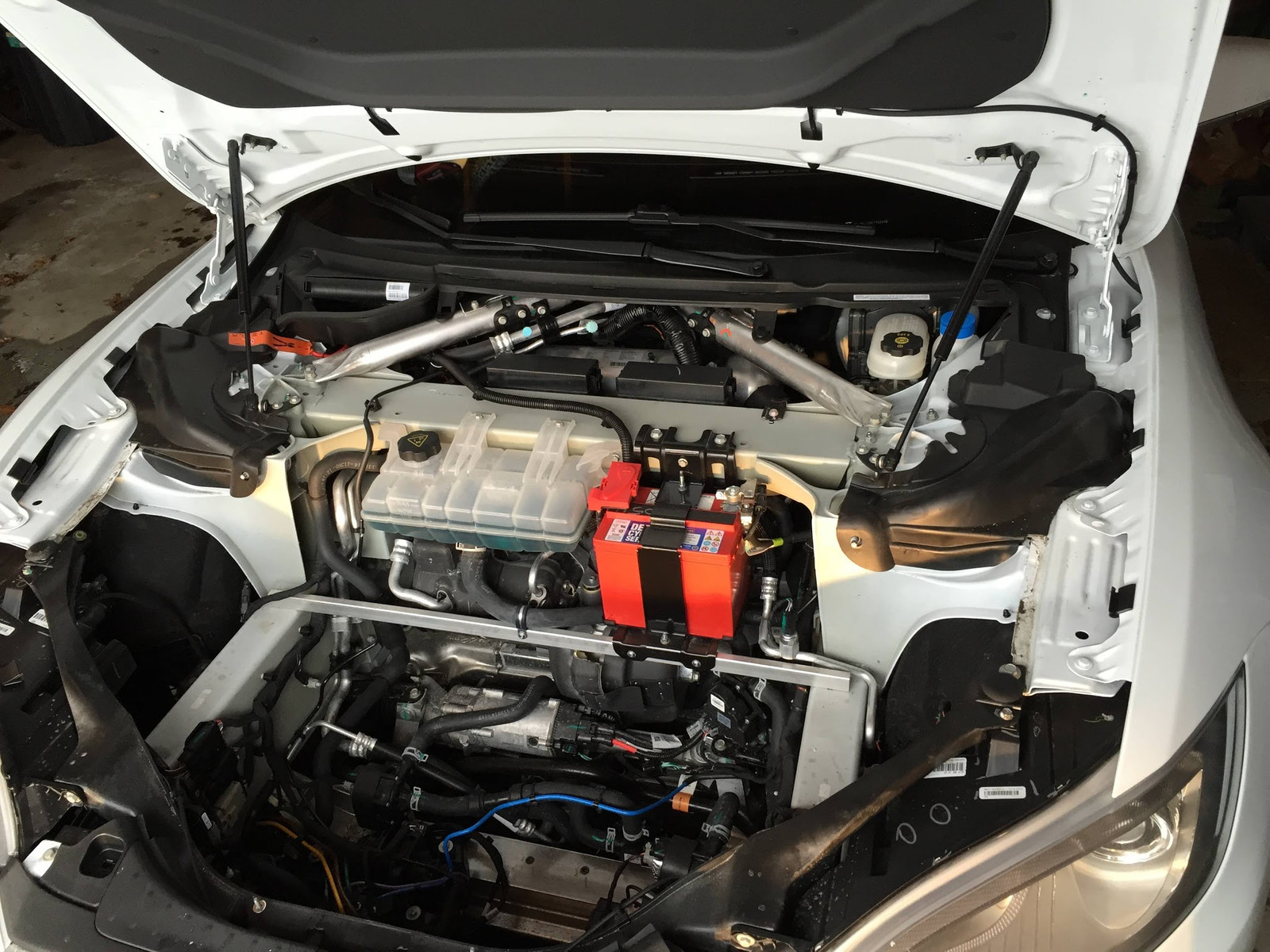
The battery is a C&D Technologies DCS-33RIT, at least in many of the cars. I don’t know if they’ve changed to a new battery or not on the brand new vehicles.
What’s in a DCS-33RIT? There are a few data sheets: a DCS-33 specific data sheet, and a data sheet for the whole DCS series. There’s also an installation manual for rack mounted batteries, but it includes some charging instructions.
Between them, one can extract a few important things:
- Capacity is 33Ah (amp-hours).
- General design is AGM - Absorbed Glass Mat.
- Float charging voltage: 13.5-13.8V
- Service charging voltage: 14.4-14.8V
- Freshening equalization voltage is 14.5V
- Recommended charge rate is C/5A at the 20h rate (6.6A)
- Cycle life at 50% depth of discharge is 1800 cycles, at 20% depth of discharge is 5700 cycles.
- This is a standard valve regulated battery (it vents overpressure).
So… pretty much a bog standard AGM battery. Nothing exciting, though the capacity (33Ah/12V - it’s only ~400Wh fully drained) seems quite low for a car that pulls so much standby current.
Model S 12V Charging System
How does the Model S charge the 12V battery? From the main battery, of course!
There’s a programmable DC-DC converter in the system that steps the main pack voltage down to the voltage needed to charge the 12V battery (and run the 12V system). That serves the same function as the alternator in an internal combustion car, though it’s under computer control (as observed below).
This means that the 12V system has to be online to charge the 12V system - if the 12V system is dead, the computers won’t engage the contactor to turn the main battery bank on, and it can’t recharge.
Model S 12V Behavior Analysis
Onto the analysis from the data I have. The images zoom if you click on them - I opted for maximum data in the image and the don’t scale down quite as nicely as I’d hoped. So click on them if you want to see the full graph.
Three Days of 12V Voltage & Amperage
Here’s the full log over roughly three days. It’s broken by color into day to make it easier to see the cycle count per day.
Two things stand out here to me.
First, the number of cycles per day is absurd. The car is putting 5 cycles a day on the 12V battery. That’s rather high - so that long cycle life rating doesn’t mean what it normally does. At 5 cycles a day, a year is 1825 cycles. At 50% depth of discharge… well, that’s your battery life and then some.
The second thing that stands out is those spikes. That’s 15.8V - four times in three days. If it were once, I’d write it off as a weird event, but it’s quite frequent. It’s apparently quite deliberate - it occurs at the end of the charge cycle, and is the final stage before the charger shuts down for a while.
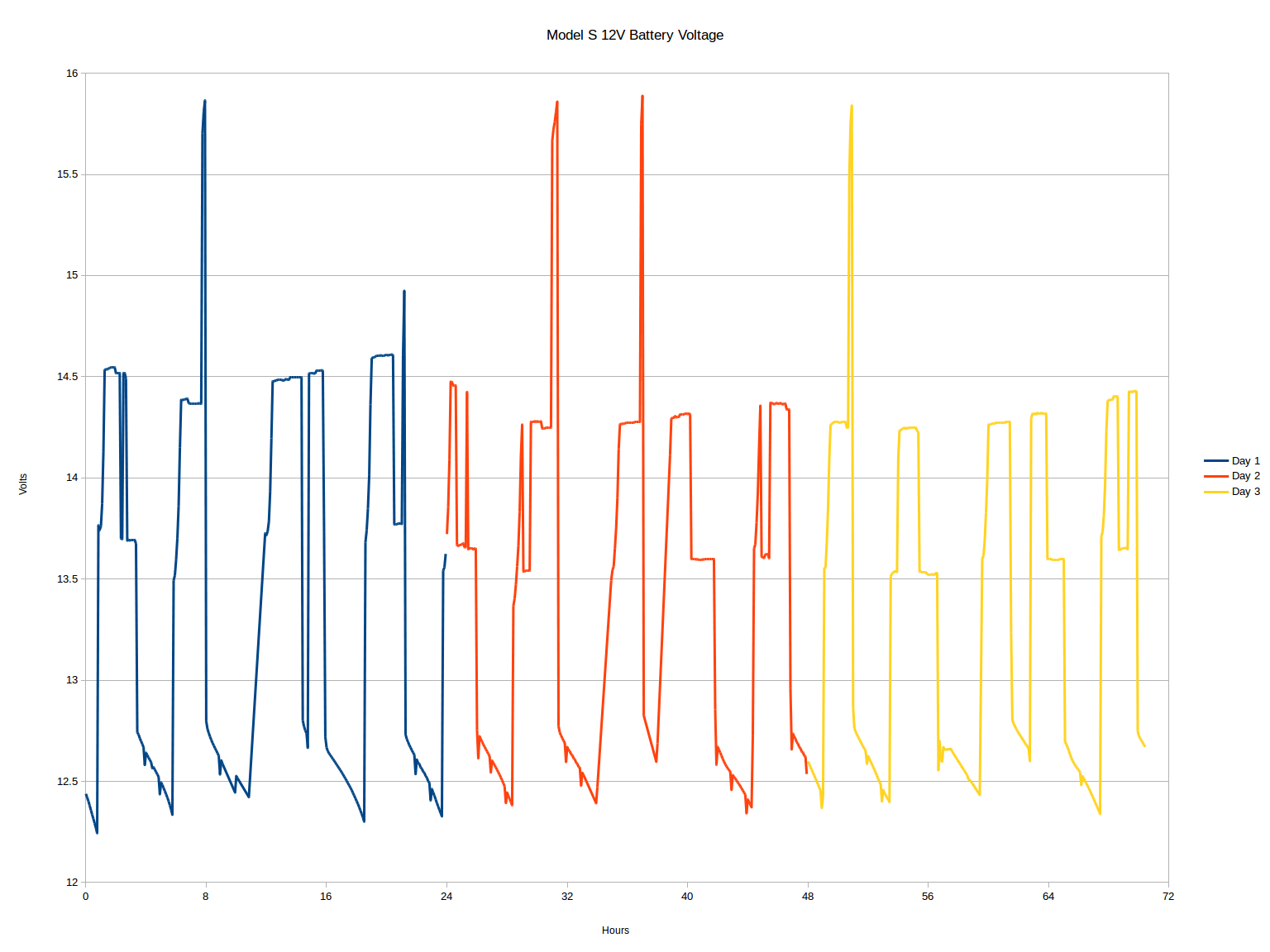
The charging amperage looks about like one would expect. It starts out around 6.5-7A (in the recommended range), and tapers off as the battery charges - this is normal. It looks like charging cuts off around 0.5A or a bit lower, then the battery voltage drops off as the charger disconnects and the battery runs the loads.
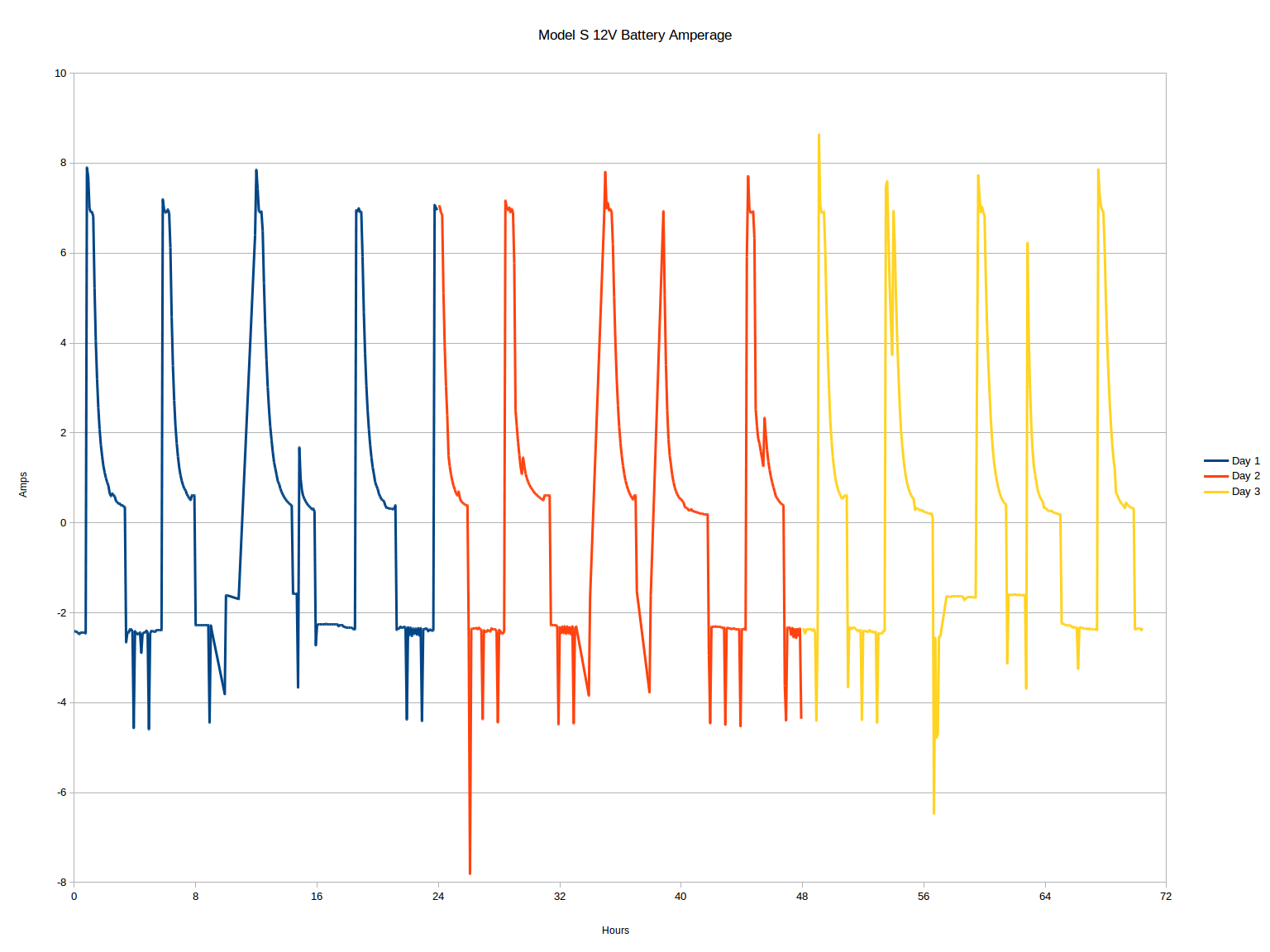
Finally, I’ve done Maths (TM) and come up with a wattage chart for charging and discharging.
Charging is less interesting than discharge - but on the discharge side, you can see that the car almost always draws 30W, and occasionally pulls a good bit more out of the battery. I don’t have particularly fine grained data here, so those spikes are long enough to be significant.
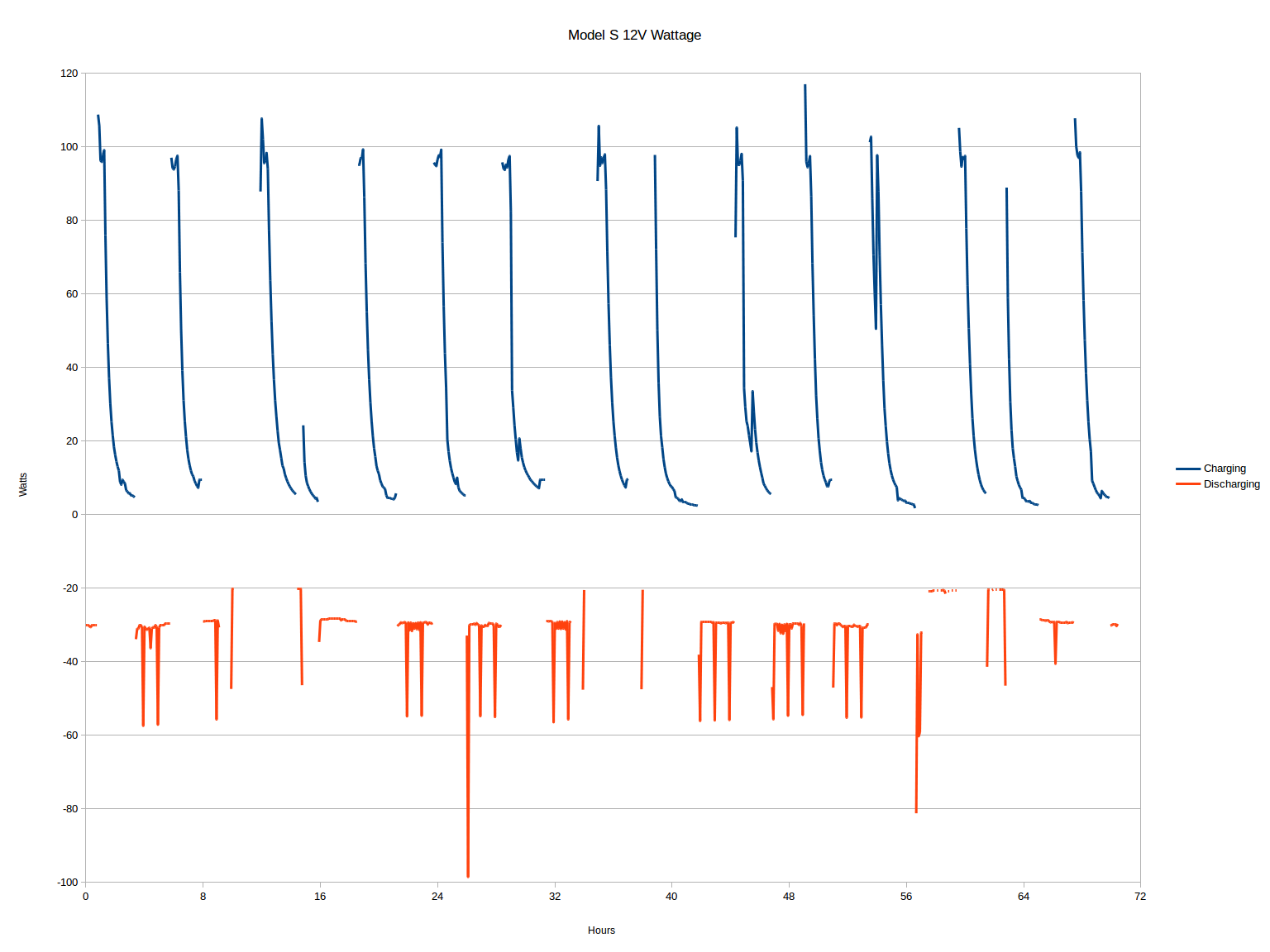
Behavior While Driving
When driving, the car seems to run the 12V system at a moderate float charge voltage. It holds the voltage between about 13.5V and 13.8V, and I suspect that the differences here are related to temperature of the battery (as the battery charging is temperature compensated - see below). This voltage means that the battery is neither charging or discharging (it might be charging, very slowly, but not enough to matter). Based on the stability of the voltages, the DC-DC converter is constantly on, and is targeting this voltage regardless of loads. I have no idea what that spike in the green chart is from, so it’s probably safe to ignore.
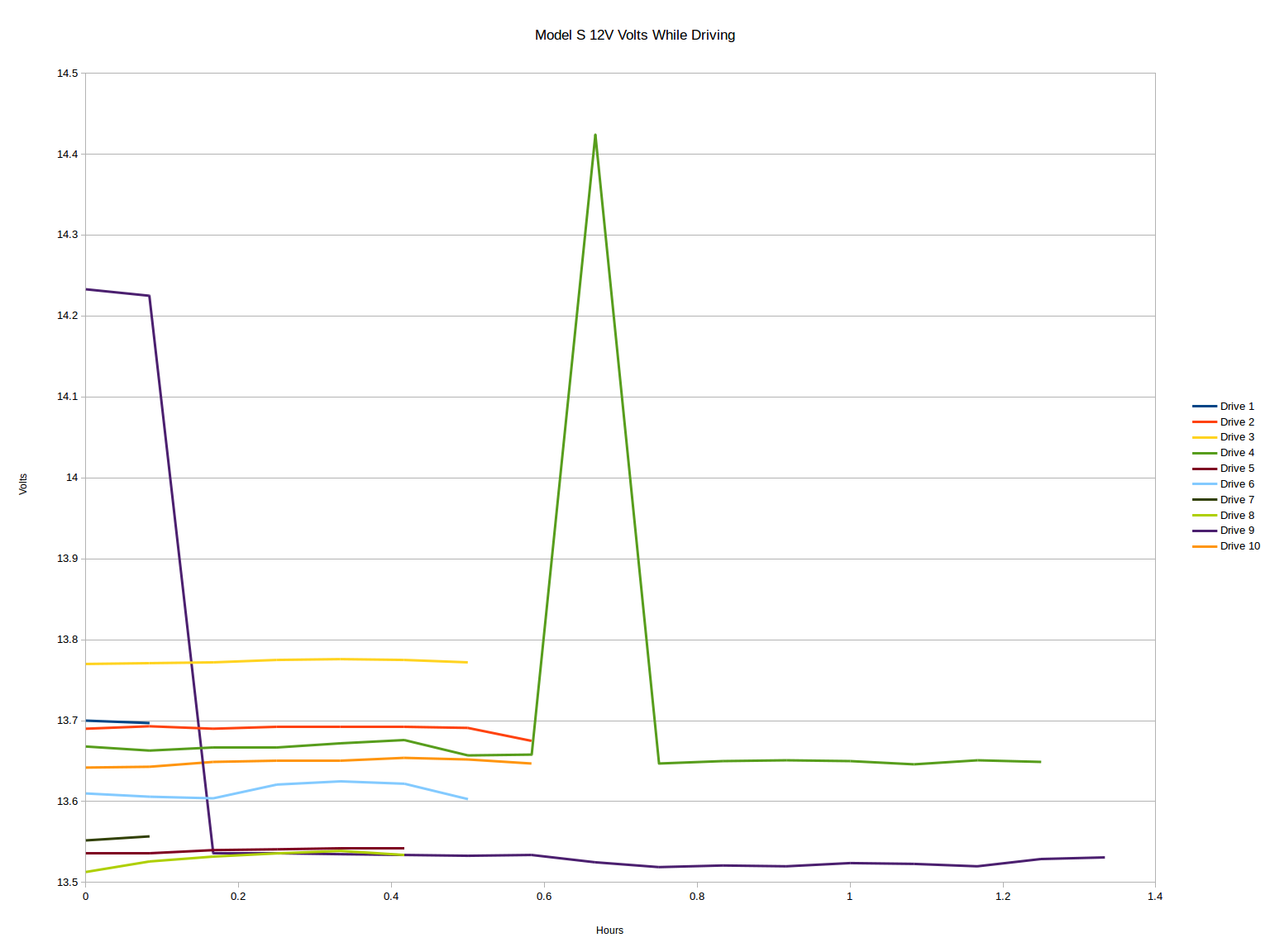
Charge/Discharge Behavior
I did two charts related to charge/discharge behavior, comparing all the cycles together. This first one starts at the beginning of a charge cycle and goes to the end of the discharge cycle. The second one is the same data, lined up at the start of the discharge part.
And… I’m not entirely sure what to make of this, if I’m honest. It’s a bit all over the place. There’s significant time spent charging at 14.5V, significant time down at 13.5V, and those weird spikes to 15.8V, right at the end of the charge cycle. They look like equalization, but… it’s an AGM battery. Those don’t need to be blasted like that.
The total charge/discharge cycle time ranges from 3.5-6h - so 4-8 cycles a day.
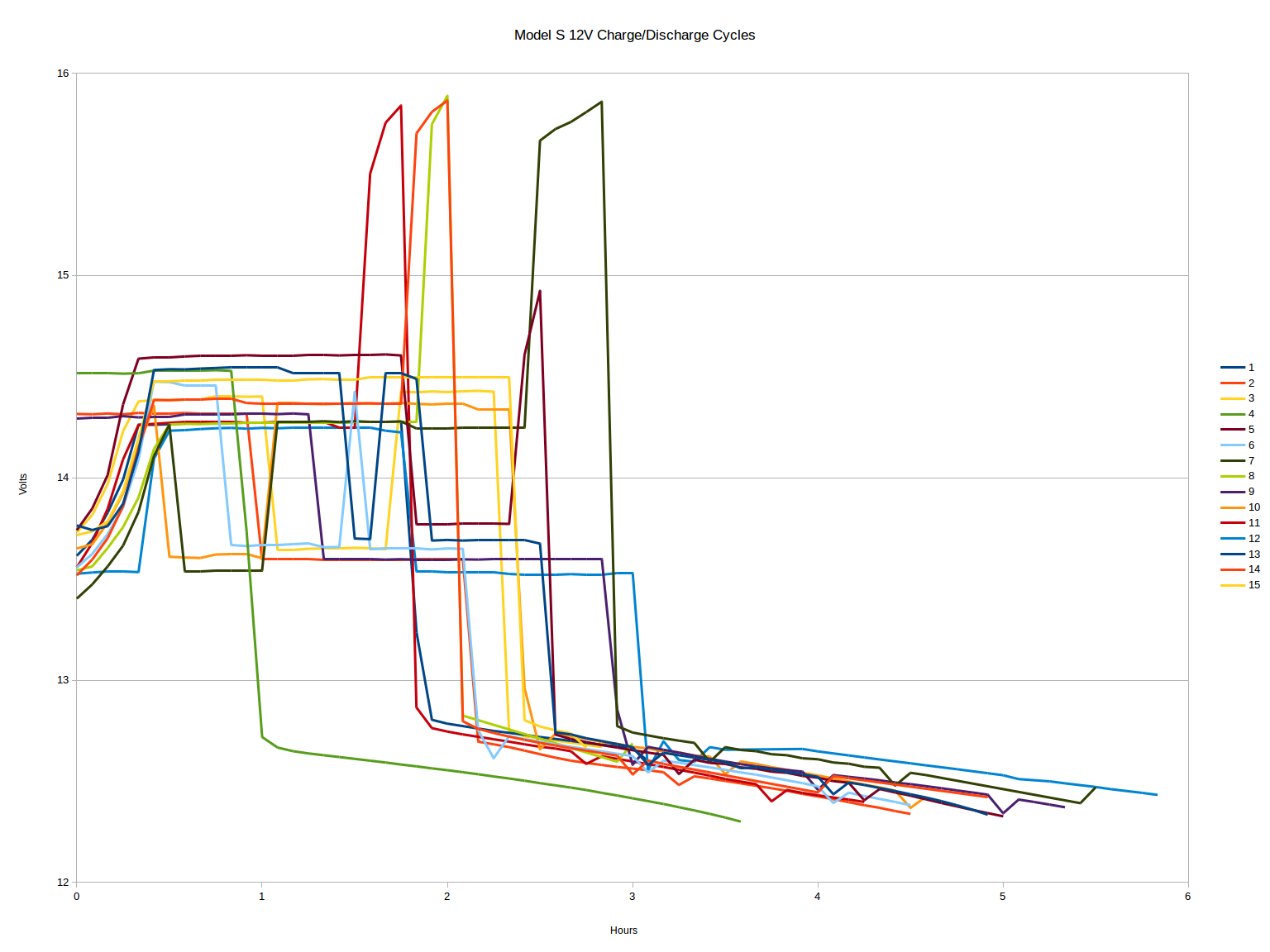
Lining up from the start of discharge, the discharge interval is pretty constant. It’s right in the 2-2.5h range, reliably. At 30W, that’s around 60-80Wh, though there are those spikes to higher drains. If I ballpark 40W as an average, that’s 80-100Wh per discharge cycle. That’s only 25% of the battery capacity, so it should be good for 5000+ cycles per the spec sheet. Obviously, it’s not lasting that long.
It’s really obvious here that the high voltage is always at the very end of the charge cycle.
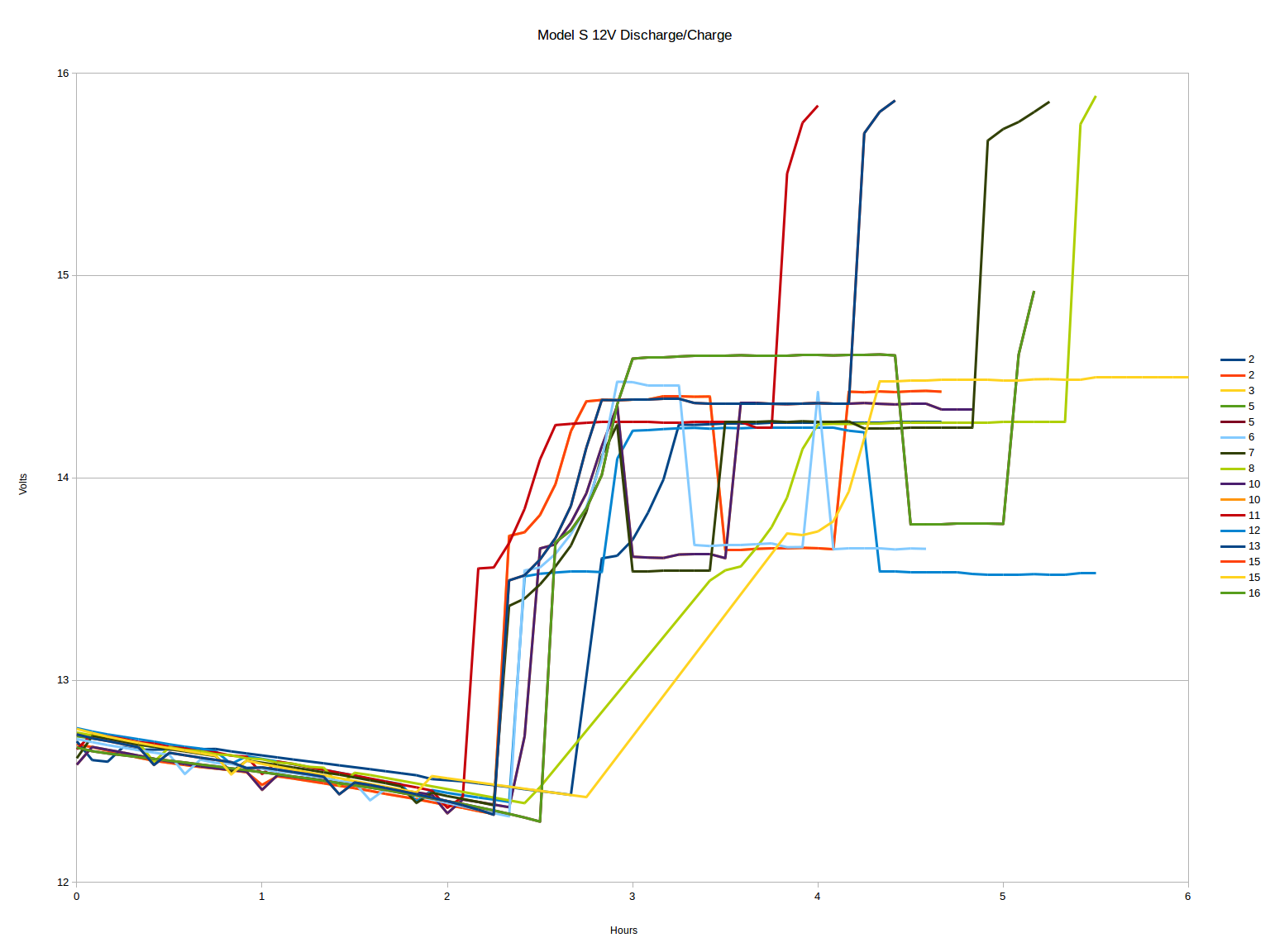
Behavior While Charging the Main Battery
While the car is actually charging, the behavior is slightly different - it performs what looks like a standard three stage charge, dropping back to float after a little over an hour.
What’s float? A lower voltage, used after the battery is fully charged, that is a “safe” voltage for indefinite storage. Normally, you charge the battery to the higher absorb/service charge voltage (around 14.5V for these), then after doing that for a while, you drop back to the float voltage (13.5V) and stay there. The battery isn’t really charging, isn’t really discharging, isn’t trying to recombine anything, and it’s a mostly static place for the battery to hang out. This is good for longevity - it’s not adding cycles, it’s not creating gas, it’s just sitting there.
This is quite clear in the red and green lines - the battery is charged at 14.2V for an hour or so, then the car drops back to 13.6V and holds it there for the remainder of the charge. This is a great use of “shore power” - no cycles on the battery. I’m a bit surprised that the higher voltage charge interval is so short, though. Lead acid takes a while to charge.
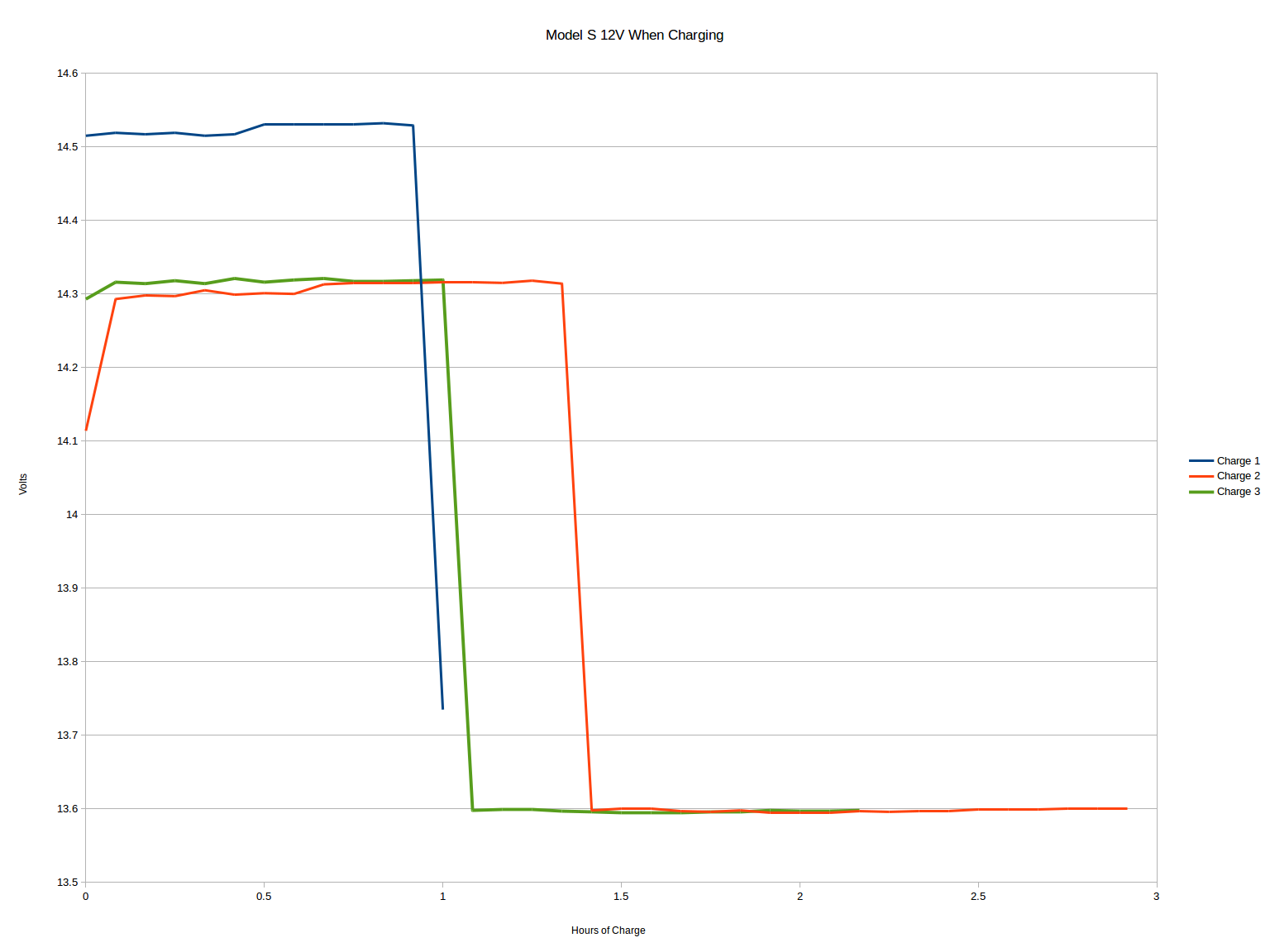
The data I got included some scheduled charging starts as well, and some time spent plugged in after the charge was finished.
This is a plot of the 12V system voltage during the times when the car is plugged into the wall. You can see the float periods on both the red and green lines (the flat parts at 13.5V), but it’s very evident that, despite having power available from the wall, the car is still cycling the 12V battery. This seems a bit silly to me. I can faintly understand “You said don’t start until 1AM, so I’m not going to draw anything from the wall” - but after the charge is finished? Why drop out of float at all? Just keep using shore power to keep the 12V battery happy. It could probably use a few hours at float (or higher) to charge it up fully.
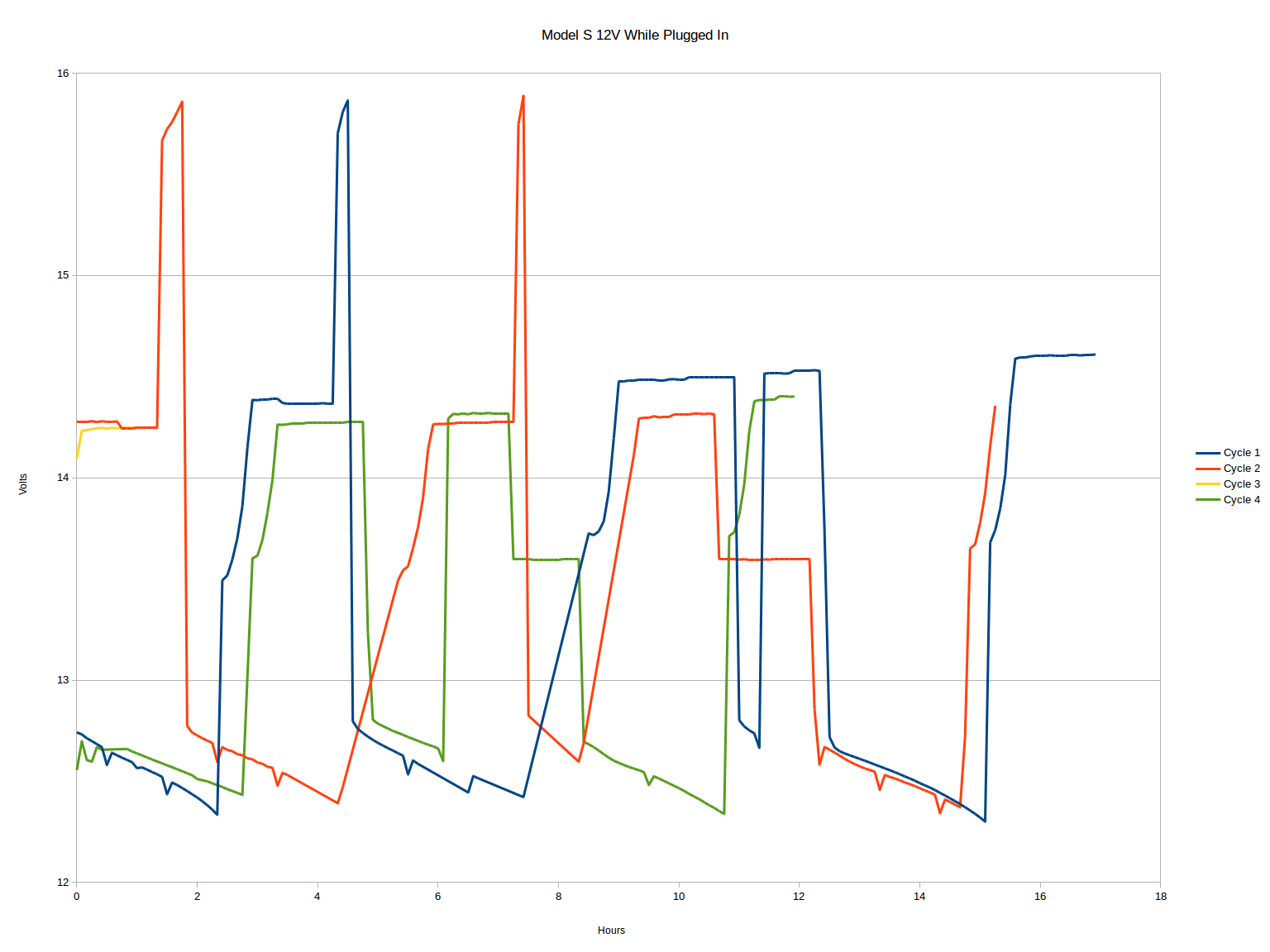
Temperature Compensation
Finally, I looked into the temperature compensation behavior of the system. Lead acid requires different charging voltages at different temperatures (a common compensation is -0.005V per cell, per degree Celcius - so 0.03V per degree for a six cell car battery).
And… yup. They’re doing some sort of temperature compensation. I graphed the “end of charge” voltages vs temperature here. You can see the weird high voltage stuff at the top, the normal charges at in the middle, and the float stages at the bottom. I haven’t checked the actual slope, but it’s quite clear that the car is doing some sort of temperature correction - which is a good thing.
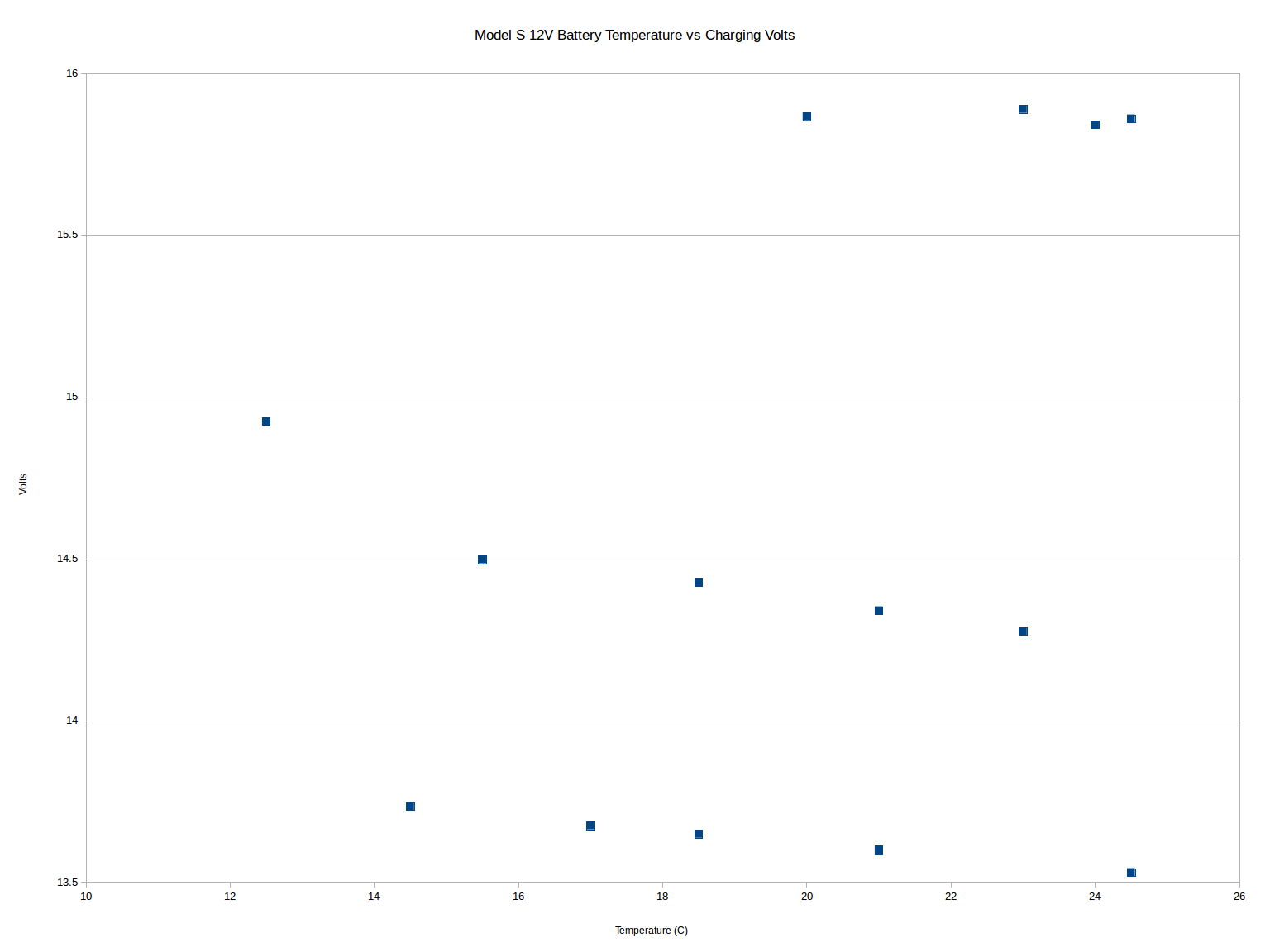
My Analysis
So… why does the Model S chew through 12V batteries? Here are my thoughts on the issue.
First, the car is cycling the battery furiously - 5+ cycles per day. Lead acid is damaged by cycles, by chronic undercharging, and also by overcharging. It’s a remarkably robust chemistry in that it shrugs off a lot of abuse and will keep functioning, but you pay in longevity. A well maintained lead acid battery can last 10 years or longer, while the same battery, abused, will die (be murdered, really) inside a year. Tesla is putting an insane number of cycles on this battery, so even in the best case, where everything else is right, it’s going to die sooner than most people would expect. 5000 cycles at 5 cycles a day isn’t even 3 years, and it’s clear that the batteries are dying far sooner than that, around 1500-2500 cycles, in many cases. That’s not an unreasonable lifespan for a lead acid battery, but a year is an unreasonably short time for a car battery.
Second, I’m not convinced that the charge time per cycle is enough. The initial charge current is fine, and the taper off is normal, but I’m not convinced that this battery is ever really 100% charged. Being fully charged on a regular basis is essential to prevent sulfation of the negative plate, and it helps balance charge between positive and negative plates as well. It’s hard to tell state of charge by voltage, and mostly impossible to tell by voltage on a system with constant drain - you have to check specific gravity, which is more or less impossible on an AGM. But there’s no sustained charge period I’ve seen, other than the float window while the main battery is charging - and that’s not enough to really reset things. Tesla might be trying to accomplish a full charge with those voltage spikes, but…
Third, those voltage spikes. Whiskey Tango Foxtrot. At no point in the data sheet do I find anything that says, “Hey, blast me with almost 16V on a daily basis.” They look like an attempt to either equalize the battery or fully charge the battery, but what they’re most likely doing is creating more gasses than the battery can recombine internally. When this happens, the valves (“valve regulated” - remember?) go into action and the battery vents some hydrogen and oxygen - but that’s lost to the battery forever. Venting a sealed battery is a great way to permanently shorten its life. I’ve also seen reports that the failed batteries are bulging, which is consistent with high internal pressure from this.
I don’t think Tesla is deliberately trying to kill this battery quickly, but given this data series, I’m not one bit surprised that they die so rapidly. It kind of looks like they’re trying to treat it like a lithium battery - “close enough to fully charged” and repeated cycling is more or less fine for lithium, but it’s a great way to kill a lead acid battery in a hurry. They have sit at a higher voltage for a long period of time, somewhat regularly, if you want anything resembling rated life.
Were one to tear down a dead 12V battery that the Model S killed, I expect you’d find badly sulfated plates from chronic undercharging, as well as dry glass mats and a very high specific gravity acid remaining (the water will separate and vent, but the acid does not).
What Can Tesla Do?
If someone were to tell me, “Fix the Model S 12V battery longevity issues,” I’d take the following steps. Remember, I’m not a world class battery expert, but I do have an interest in lead acid longevity. Some tweaks are software, some are hardware.
- Put a bigger battery in. This battery is just too small for the car. Double or triple the size, pay the weight penalty (this is a 27lb battery, so 3x the size would only be an extra 50 lbs), and put something decently sized in - then adjust the software for it. You can reduce the cycle count significantly with a larger battery, and if you change nothing else, that should take the battery from a 1-1.5 year life to a 3-5 year life - much more reasonable.
- Find a way to perform longer absorb cycles, at least once a day. Lead can handle partial state of charge cycling decently, as long as it gets a good absorb cycle (so around 14.5V) regularly - you have to get it up there and let it sit to reabsorb the sulfate crystals into the acid and balance the plates. You can do this while plugged in at night, and I don’t think it would hurt anything to run the higher voltage (14.5V or so) while driving. That’s how a normal car charges the battery.
- Keep cycles off the battery whenever you can - whenever shore power (the charger) is connected. If the car is connected to a charger, you shouldn’t be cycling the 12V battery up and down. Charge it, let it absorb for a while (a few hours is good), drop to float. Stay there until disconnected from the charger. I understand if they’re reluctant to pull any current before the charge time, but I’d do that and add an advanced option to cancel it. Float time on an AGM battery is “free” - it doesn’t do anything to degrade the battery.
- Eliminate those 15.8V spikes entirely. If you have longer absorb times (around 14.5V), the battery should be in good shape without any need to zap it like this. As a bonus, you won’t have as much gassing and loss of water. Bulging batteries mean gassing, and high voltage causes gassing. AGM is much less forgiving of a high voltage than flooded lead acid.
- Sleep the computers when possible. The car is constantly drawing 30W and regularly pulls more - when turned off. I don’t know what exactly goes on, but maybe some of it could happen when charging. In the realm of greater hardware redesign, a low power standby computer for handling stuff that always has to happen would help.
- Or maybe just leave the DC-DC converter on. I have no idea what the losses running that are, but lead acid charging is far from 100% efficient. It may be easier to just hold the battery at a float charge most of the time.
I expect those changes would radically improve the 12V battery longevity. Even if you can’t put a larger battery in, changing the behavior to reduce the cycles on the battery should help a lot, as should letting it charge for longer when possible. I’m pretty sure that can be done in software.
Again, I’m not a professional battery engineer - just a guy who makes a living in an office with a big bank of lead acid batteries I’m not eager to replace. These are my suggestions, based on what I see in these few days of data and what I know about lead acid. I’ve spent an awful lot of time reading up on the chemistry, though.
If anyone has data from early in the cars life, when they were just tearing through batteries, please get in touch with me. I’d love to compare with the current behavior.
If you own a Tesla - what has your experience been with the 12V battery lifespan? Let me know in the comments!
Comments
Comments are handled on my Discourse forum - you'll need to create an account there to post comments.If you've found this post useful, insightful, or informative, why not support me on Ko-fi? And if you'd like to be notified of new posts (I post every two weeks), you can follow my blog via email! Of course, if you like RSS, I support that too.
